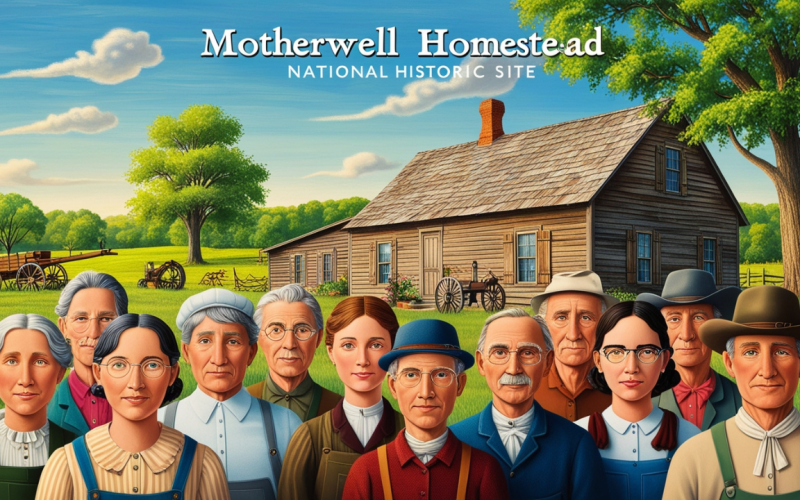Intro about Motherwell Homestead National Historic Site
Motherwell Homestead National Historic Site, Nestled in the fertile land of the Qu’Appelle region, Motherwell Homestead National Historic Site is a testament to Canada’s agricultural roots.
Located just an hour’s drive east of Regina, in Abernethy, Saskatchewan, this historic gem commemorates the life and achievements of William Richard Motherwell, a pioneer of scientific agriculture and Saskatchewan’s first Minister of Agriculture. The site offers a chance to step back in time and experience the life of a prairie homesteader in the early 1900s.
Key Takeaways
- Motherwell Homestead showcases life on a 1900s prairie farm.
- The site honours William Richard Motherwell’s agricultural legacy.
- Visitors can explore restored fieldstone buildings and barns.
- The site is located in Abernethy, Saskatchewan, Canada.
- It provides hands-on experiences and historical insights.
What is the Motherwell Homestead National Historic Site?
The Motherwell Homestead National Historic Site was established to preserve and celebrate the contributions of William Richard Motherwell to Canadian agriculture.
This beautifully restored farmstead, operated by Parks Canada, highlights the challenges and triumphs of homesteaders who transformed the vast prairies into fertile farmland during the late 19th and early 20th centuries.
A Symbol of Agricultural Resilience
The homestead vividly captures the essence of prairie life with its historic buildings, lush fields, and the practical ingenuity of its design. Beyond its architectural beauty, it stands as a tribute to the resilience and vision of settlers who laid the foundation for Canada’s agricultural advancements.
Who Was William Richard Motherwell?
W.R. Motherwell: The Man Behind the Legacy
William Richard Motherwell, often called W.R. Motherwell, was a farmer, politician, and pioneer of scientific agriculture. Born in Ontario, he moved to Saskatchewan in the late 19th century and established a farm called Lanark Place, now preserved as the Motherwell Homestead.
Contributions to Agriculture
Motherwell played a pivotal role in advancing farming practices, advocating for crop rotation and shelter belts to combat soil erosion.
He became Saskatchewan’s first Minister of Agriculture and later served as Canada’s federal Minister of Agriculture under the Mackenzie King government. His legacy lies in promoting sustainable and innovative farming techniques that transformed the Canadian prairies.
Life on the Prairie in the 1900s
Homesteading on the Prairies
The prairie landscape of the early 1900s was both beautiful and unforgiving. Homesteaders faced harsh winters, unpredictable weather, and the challenge of taming vast stretches of wild land. Settlers built homes from durable materials like fieldstone and planted shelter belts—rows of shrubs and trees—to protect their fields from wind erosion.
Daily Life of Settlers
Life revolved around the seasons. Spring brought planting, summer meant tending crops, fall was for harvesting, and winter involved preparation for the year ahead. Despite the challenges, the prairies provided opportunities for settlers to build new lives and contribute to Canada’s growing agricultural economy.
Exploring the Homestead Today
Historic Buildings and Structures
Visitors to the Motherwell Homestead can explore a range of restored structures, including the iconic fieldstone house, which offers a glimpse into the life of a 1907 prairie family. Other attractions include barns, implement sheds, and granaries, each showcasing the tools and techniques used by early farmers.
Interactive Experiences
The homestead brings history to life with hands-on activities. Visitors can try traditional farming tasks, explore the fields, or simply enjoy the scenic beauty of the Qu’Appelle region. The landscape itself tells a story, with its fields divided by fences and lined with shelter belt shrubs and trees.
Key Features of Prairie Life
| Feature | Description | Purpose |
| Shelter Belts | Rows of trees and shrubs | Wind protection for crops |
| Fieldstone Buildings | Durable homes and barns | Resilience against weather |
| Dugouts | Water storage | Essential for farming |
| Fenced Fields | Quadrant divisions for efficiency | Organized farming operations |
The Qu’Appelle Region: A Cultural Crossroads
The Fertile Land of the Qu’Appelle
The Qu’Appelle region was a cultural crossroads for Métis settlers, First Nations, and waves of immigrants who brought diverse traditions and practices to the area. This fertile land attracted settlers from across Canada, contributing to its rich history and agricultural success.
Community and Cooperation
Settlers relied on each other for support and innovation. Villages like Abernethy and Indian Head became hubs for trading goods and sharing farming knowledge. The railway also played a vital role in connecting the region to broader markets, boosting the local economy.
Why Visit the Motherwell Homestead National Historic Site?
Learn About Agricultural History
The site offers an in-depth look at the evolution of farming in Canada, from the challenges of early subsistence farming to the adoption of innovative techniques like crop rotation and windbreaks.
Connect With Nature
The serene setting of the homestead, surrounded by lush fields and shelter belts, provides a peaceful escape. Visitors can experience the beauty of the prairie landscape while learning about its ecological and cultural significance.
Experience Living History
The homestead’s interactive exhibits, from exploring the fieldstone house to trying hands-on farming activities, make it a fun and educational experience for visitors of all ages.
Planning Your Visit
Location and Accessibility
The Motherwell Homestead is located in Abernethy, Saskatchewan, about an hour’s drive east of Regina. It is easily accessible via Indian Head and close to landmarks like Buffalo Lake.
Best Time to Visit
The site is open seasonally, from late spring to early fall. These months are ideal for exploring the fields, enjoying wagon rides, and participating in events organized by Parks Canada.
Visitor Tips
| Tip | Details |
| Comfortable Clothing | Wear sturdy shoes and weather-appropriate attire. |
| Essentials | Bring water, sunscreen, and a camera. |
| Check Schedule | Visit the Parks Canada website for event updates. |
FAQs About Motherwell Homestead National Historic Site
Q1. Where is Motherwell Homestead located?
It’s in Abernethy, Saskatchewan, an hour’s drive east of Regina.
Q2. What can you do at the site?
Visitors can explore restored buildings, try hands-on activities, and learn about prairie history.
Q3. Is the site family-friendly?
Yes, it offers engaging activities for visitors of all ages, including kids.
Q4. When is the best time to visit?
The site is open seasonally, from late spring to early fall, offering the best weather and activities.
The Architecture of the Homestead
The Fieldstone House: A Centerpiece of Prairie Ingenuity
The fieldstone house is a hallmark of the Motherwell Homestead, representing both practicality and durability. Built in 1907, this two-story home reflects the resilience of settlers who used locally available materials to combat harsh prairie winters. Inside, its period furnishings and layout offer an authentic glimpse into daily life over a century ago.
The Role of Outbuildings
The various outbuildings, including barns, granaries, and implement sheds, were essential for the functionality of the farm. These structures supported diverse farming activities, from housing livestock to storing tools and crops, ensuring the homestead operated efficiently.
Innovations in Prairie Farming
Shelter Belts: Pioneering Protection
The introduction of shelter belts—rows of trees and shrubs planted strategically around fields—was one of the most transformative innovations in prairie farming. Promoted by William Richard Motherwell, these natural windbreaks not only protected crops from wind erosion but also helped conserve soil moisture.
The Rise of Scientific Agriculture
William Richard Motherwell championed the adoption of scientific agriculture, which involved advanced techniques like crop rotation, soil analysis, and sustainable land use. These practices marked a shift from traditional subsistence farming to more efficient and environmentally conscious methods.
The Cultural and Historical Significance of the Qu’Appelle Region
The Fertile Land of the Qu’Appelle
The Qu’Appelle region was prized for its fertile soil, making it an ideal location for early settlers. This land became a hub for agricultural development and a symbol of opportunity for those who sought a better future on Canada’s prairies.
A Crossroads of Cultures
The Qu’Appelle region was more than just farmland—it was a meeting place for diverse cultures, including Métis settlers, First Nations communities, and immigrants. These groups brought unique farming techniques and traditions, enriching the region’s agricultural practices and history.
Sustainable Farming Lessons from the Past
Timeless Farming Practices
The practices pioneered at the Motherwell Homestead, such as crop rotation and shelter belt planting, remain relevant today. These methods exemplify how sustainable farming techniques can maintain soil health and productivity over generations.
Adapting Prairie Ingenuity for Modern Challenges
The ingenuity of early settlers continues to inspire modern farming, particularly in addressing contemporary challenges like climate change and soil degradation. The lessons learned from the homestead provide a foundation for developing resilient agricultural practices.
Seasonal Events and Activities at the Homestead
Celebrating Prairie Heritage
The Motherwell Homestead hosts a variety of events throughout the year, including harvest festivals and pioneer demonstrations. These celebrations offer visitors a chance to experience the rhythms of prairie life and connect with the legacy of early settlers.
Hands-On Learning Experiences
Interactive activities, such as wagon rides, livestock care, and vintage farming demonstrations, allow visitors to step into the shoes of a 1900s homesteader. These experiences bring history to life and make the site accessible and engaging for all ages.
The Homestead’s Role in Canadian History
Lanark Place as a Model Homestead
The Motherwell Homestead, originally known as Lanark Place, set a standard for future farmsteads across Saskatchewan and Ontario. Its design and functionality influenced how settlers approached the challenges of prairie life.
National Recognition
The homestead’s designation as a National Historic Site of Canada highlights its significance in the nation’s agricultural and cultural heritage. It stands as a symbol of innovation, resilience, and the pioneering spirit of early settlers.
My Opinion
The Motherwell Homestead National Historic Site is a window into Canada’s agricultural past. From its beautifully restored buildings to the immersive hands-on experiences, it offers visitors a unique opportunity to connect with history, nature, and the legacy of William Richard Motherwell.
Whether you’re a history buff, a nature lover, or simply curious about life on the prairies, this site is a must-visit destination. Plan your trip today and step into the world of a 1900s prairie homesteader!







